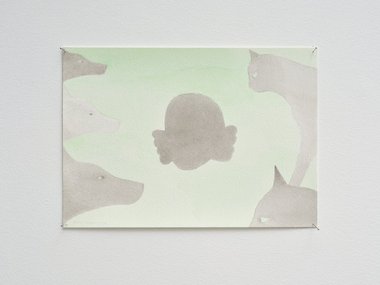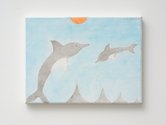John Hurrell – 30 October, 2024
On these painted sheets featuring thin acrylic washes, Harrison's delicate translucent heads (human, feline, canine) extend inwards, face to face, accentuating an ocular connection across a quivering blank field. This background—a pale floating void—is contained within the framing edges of loaded pastel profiles and is like an open unwritten list of potential aims. Ghosts of want waiting to be selected. Faint evanescent possibilities of passing desire.
When we look through Harrison’s assorted soft smoky images, even depicted jigsaw puzzle pieces can be found inserted amongst rendered cats and other shape-oriented subject matter; perhaps as a comment on compositional process and this painter’s consideration of organisation via negative space. Or as a comment on the forces that drive desire and sexual / emotional compatibility.
In our conversations humans are often ascribed with properties associated with animal behaviour—such as ferocity—but do we find that animals love the way that humans do? Pets definitely have memories, but do they have plans? Do they have hopes built on anticipation and longing?
On these painted sheets featuring thin acrylic washes, Harrison’s delicate translucent heads (human, feline, canine) extend inwards, face to face, accentuating an ocular connection across a quivering blank field. This background—a pale floating void—is contained within the framing edges of carefully shaped profiles and is like an open unwritten list of potential aims. Ghosts of want waiting to be selected. Faint evanescent possibilities of passing desire.
Many exhibits, such as Tearaway, calculatedly exploit semantic ambiguities. In this case it can be a ripped petticoat, a frayed cat, an owl, or an elderly woman’s jagged face.
One painting, with three dogs on one side and two cats on the other, has the shape of what seems to be a stack of bowler hats in the middle. That shape could also be a female head, abstracted with an elaborate hairstyle or flapper hat, someone who is about to choose a pet.
Another work, Spaced Out, shows an image of two nuzzling cats silhouetted within the head of a third. In other words, it depicts a cat thinking about other felines. Harrison clearly likes to ponder over cat thought (their processes of consciousness): activity for them that is apparently pleasurable, particularly if they are scheming on how to make a friend or catch prey. He is an artist who delights in speculating about cat psychology, particularly about the nature of their affections—where they are directed and why—and introducing parallels with the human heart.
John Hurrell










 Two Rooms presents a program of residencies and projects
Two Rooms presents a program of residencies and projects Advertising in this column
Advertising in this column



This Discussion has 0 comments.
Comment
Participate
Register to Participate.
Sign in
Sign in to an existing account.